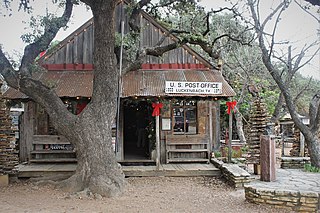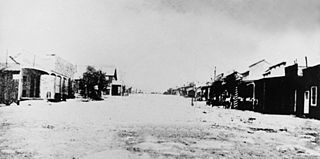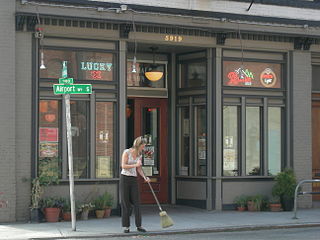Winkelmann | |
|---|---|
 Winkelmann in 2009 | |
| Country | United States |
| State | Texas |
| County | Washington |
| Named for | Ray Winkelmann |
Winkelmann is a heritage tourist ghost town in Washington County, Texas, United States.
Winkelmann | |
|---|---|
 Winkelmann in 2009 | |
| Country | United States |
| State | Texas |
| County | Washington |
| Named for | Ray Winkelmann |
Winkelmann is a heritage tourist ghost town in Washington County, Texas, United States.
Local developer and antiques dealer Ray Winkelmann purchased and collected about 150 historical buildings. In 1983, he purchased a five-acre plot outside of Brenham, on U.S. Route 290, and moved 19 buildings to the property. The restored structures included schoolhouses, plantation houses, a saloon, and a general store. Tourists arrived and Winkelmann operated the saloon, the general store and a restaurant, and leased other buildings to local businesses. The town became a group tour destination, with upwards of 90 people working there at its peak. [1] [2] [3]
In 1986, during an economic downturn, the town was lost to the Washington County State Bank. It was auctioned in 1989, went through several ownerships, and was abandoned by 1994. [1] In 2022, one building and a restaurant sign were left standing. [2]

Goodsprings is an unincorporated community in Clark County, Nevada, United States. The Pioneer Saloon and the Goodsprings School house were both built in 1913 and are still in use to this day. The town was once a prosperous mining town before seeing a significant decline in the population. The population was 229 as of the 2010 census. Due to this, the town of Goodsprings has been characterized as a ghost town.
Trinity is a city in Trinity County, Texas, United States. The population was 2,343 at the 2020 census.

Knott's Berry Farm is a 57-acre (2,500,000 sq ft) amusement park in Buena Park, California, United States, owned and operated by Six Flags. In March 2015, it was ranked as the twelfth-most-visited theme park in North America, while averaging approximately 4 million visitors per year. The park features over 40 rides, including roller coasters, family rides, dark rides, and water rides.

Calico is a ghost town and former mining town in San Bernardino County, California, United States. Located in the Calico Mountains of the Mojave Desert region of Southern California, it was founded in 1881 as a silver mining town, and was later converted into a county park named Calico Ghost Town. Located off Interstate 15, it lies 3 miles (4.8 km) equidistant from Barstow and Yermo. Giant letters spelling CALICO are visible, from the highway, on the Calico Peaks behind it. Walter Knott purchased Calico in the 1950s, and rebuilt all but the five remaining original buildings to look as they did in the 1880s. Calico received California Historical Landmark #782, and in 2005 was proclaimed by then-Governor Arnold Schwarzenegger to be California's Silver Rush Ghost Town.

Luckenbach is an unincorporated community 13 miles (19 km) from Fredericksburg in southeastern Gillespie County, Texas, United States. Named for Carl Albert Luckenbach, son of the early settler Jacob Luckenbach, the town is known as a venue for country music and for its German-Texan heritage.

Fairbank is a ghost town in Cochise County, Arizona, next to the San Pedro River. First settled in 1881, Fairbank was the closest rail stop to nearby Tombstone, which made it an important location in the development of southeastern Arizona. The town was named for Chicago investor Nathaniel Kellogg Fairbank who partially financed the railroad, and was the founder of the Grand Central Mining Company, which had an interest in the silver mines in Tombstone. Today Fairbank is located within the San Pedro Riparian National Conservation Area.
Broderick is a former town in Yolo County, California, United States, now forming part of the City of West Sacramento. It is located just west of the Sacramento River in the eastern portion of the county. Broderick's ZIP Code is 95605 and is in area codes 916 and 279. It lies at an elevation of 23 feet.

Thurber is an unincorporated community in Erath County, Texas, United States, located 75 miles west of Fort Worth. It was, between 1888 and 1921, one of the largest producers of bituminous coal in Texas and the largest company town in the state, with a population of over 10,000. The population of the community is 48 per the 2010 United States Census.

Lobo is a ghost town in Culberson County, Texas, United States, that was abandoned in 1991.

Silver Reef is a ghost town in Washington County, Utah, United States, about 15 miles (24 km) northeast of St. George and 1 mile (1.6 km) west of Leeds. Silver Reef was established after John Kemple, a prospector from Nevada, discovered a vein of silver in a sandstone formation in 1866. At first, geologists were uncertain about Kemple's find because silver is not usually found in sandstone. In 1875, two bankers from Salt Lake City sent William Barbee to the site to stake mining claims. He staked 21 claims, and an influx of miners came to work Barbee's claims and to stake their own. To accommodate the miners, Barbee established a town called Bonanza City. Property values there were high, so several miners settled on a ridge to the north of it and named their settlement Rockpile. The town was renamed Silver Reef after silver mines in nearby Pioche closed and businessmen arrived.

The architectural structures of Fredericksburg, Texas, are often unique to the Texas Hill Country, and are historical edifices of the German immigrants who settled the area in the 19th century. Many of the structures have historic designations on a state or national level. The Gillespie County Historical Society is actively involved in assisting with preservation.
Halfway, Illinois was a rough and very wet unincorporated community nicknamed "Little Juarez" in Williamson County, Illinois, at what is believed to the crossroads of Illinois Route 37 and Prosperity Road between Marion and Johnston City. Its heyday was between 1915 and 1925. The name originated because it was about halfway between Marion and Herrin, located a few miles to the west on what is now a county highway. The nickname came about from the general lawlessness, shootings and proliferation of gambling and booze, even during Prohibition.
Adobe Walls is a ghost town in Hutchinson County, 17 miles (27 km) northeast of Stinnett, in the U.S. state of Texas. It was established in 1843 as a trading post for buffalo hunters and local Native American trade in the vicinity of the Canadian River. It later became a ranching community. Historically, Adobe Walls is the site of two battles between Native Americans and settlers. In the November 1864 First Battle of Adobe Walls, Native Americans successfully repelled attacking troops led by Kit Carson. Ten years later, on June 27, 1874, known as the Second Battle of Adobe Walls, civilians at the Adobe Walls trading post successfully fought off an attack by a war party composed primarily of Comanche and Cheyenne warriors led by the Comanche chief Quanah Parker. The second battle led to a military campaign which resulted in Indian relocation to Indian Territory.

The Buckhorn Saloon & Museum is a privately run museum located at 318 E. Houston Street in Downtown San Antonio, Texas, U.S. Originally privately owned by Albert Friedrich, the Buckhorn became a tourist attraction for its unique collections. Theodore Roosevelt and his Rough Riders were reputed to frequent the establishment. Housed in 1956 in the Old Lone Star Brewery, the collection passed to Friedrich's heirs who had it moved to its current location.

Tubb Town, also known as Field City, is a ghost town in Weston County, Wyoming, United States. It was initially intended as a railroad town but quickly gained a reputation as a rough place to live, as saloons, brothels, and similar establishments became the main draw. Settled and abandoned within months during 1889, it is an early example of a boom and bust town in the Black Hills.

Searsville (c.1854–1891) was a San Mateo County, California town located in what is now the Jasper Ridge Biological Preserve on Corte Madera Creek and adjacent to Woodside. At the northwest corner of Sandhill Road and Portola Road is a plaque, and this location has been a California Historical Landmark since 1950.

Jules Maes Saloon is by some accounts the oldest bar in Seattle, in the U.S. state of Washington. It opened in 1888 in the city's Georgetown neighborhood. The building it occupies, "The Brick Store", at 5919 Airport Way at the corner of Nebraska, is listed as a Seattle Historic Site.

Stonewall Saloon or The Museum of the Stonewall Saloon is an authentic western saloon located in Saint Jo, Texas. The tavern was named as acknowledgment of Stonewall Jackson as American Civil War exiles appealed for sanctuary in what was termed "Indian country." The saloon was established in 1873 during the eminence of the cattle drive era exemplary of the late nineteenth century Old West.
Toadsuck is an alleged ghost town in Grayson County, Texas, United States.